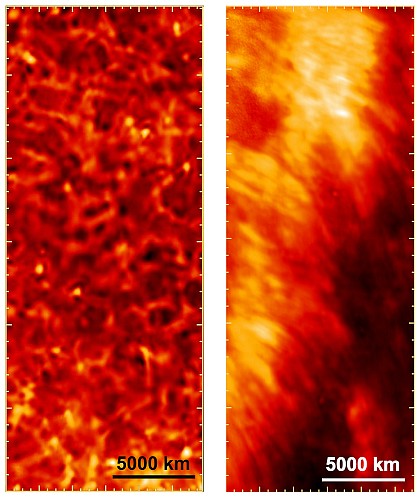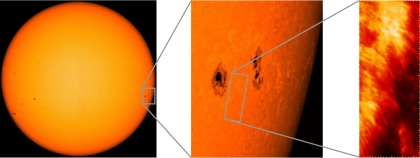Press Release 15/2013 - September 23, 2013
A unique glance into the Sun's atmosphere
For the first time, data obtained by the balloon-borne solar observatory Sunrise provide high resolution images of the Sun's chromosphere in ultraviolet light.
Three months after the flight of the balloon-borne solar observatory Sunrise, scientists from the Max Planck Institute for Solar System Research (MPS) in Germany now present unique insights into the central layer of the Sun's atmosphere, the chromosphere. The Sunrise-data provide the first high-resolution images of this region, lying between the Sun's visible surface and the corona, in ultraviolet light. More prominently than in earlier images, structures with a size of a few hundred kilometers such as bright points or strongly elongated fibrils occurring in close proximity to sunspots become visible in these wavelengths. The images therefore spark hope of finally unravelling the mysteries of the chromosphere.
The chromosphere still continues to puzzle scientists. How is it possible that with increasing distance from the Sun's hot core the temperature in this layer increases on average by 6000 Kelvin? "At first sight, this temperature distribution contradicts basic physical concepts", says Prof. Dr. Sami K. Solanki, head of the Sunrise mission and director at the MPS. The situation can be compared to a heated room in which it gets warmer with increasing distance to the heater. "Apparently, the chromosphere witnesses huge energy transformations", he adds. "Processes not yet understood in detail must provide enough energy to heat up the plasma". Data from Sunrise's first mission in 2009 had revealed acoustic waves to supply a considerable fraction of this energy. In addition, research carried out in recent years has characterized the chromosphere as a very dynamical place where hot and colder regions may lie in close proximity and are constantly in motion.

|
Abbildung 1: Images of the chromosphere taken at a wavelength of 279.6 nanometers. Left: In this quiet region a typical pattern can be seen: dark areas surrounded by bright rims. The bright points flashing up here and there can be well discerned. Right: Close to sunspots the images show bright, stretched structures.
The colors in these images stand for the intensity of the light: yellow means a high intensity, black a low intensity.
|
(Credits: MPS)
|
"In order to solve this riddle it is necessary to take as close a look as possible at the chromosphere - in all accessible wavelengths", Solanki explains. Together with colleagues from the Kiepenheuer-Institut für Sonnenphysik (Freiburg, Germany), the High Altitude Observatory (Boulder, USA), and the Instituto de Astrofísica de Andalucía (Granada, Spain) the MPS researchers were now able to fit another piece into the puzzle: the first high-resolution observations of the chromosphere in ultraviolet light.
The images were made possible by Sunrise, a balloon-borne solar observatory studying the Sun from the stratosphere. Once it reaches its float altitude of more than 37 kilometers, Sunrise hasrisen above the greatest part of the Earth's atmosphere. These layers absorb the Sun's ultraviolet radiation, making it inaccessible to ground-based solar observations. At the beginning of June of this year Sunrise was launched from Kiruna in the north of Sweden and embarked on its second journey. After five days the observatory landed on the remote Boothia Peninsula in northern Canada.
"Of course, in the past space probes have analyzed the Sun's ultraviolet light from space", says Solanki. However, they provide a lower spatial resolution. And Sunrise offers another decisive advantage: the Sunrise Filter Imager, one of the onboard scientific instruments, is able to filter certain ultraviolet parts out of the solar spectrum - for example the radiation with a wavelength of 279.6 nanometers. "Only the magnesium atoms in the chromosphere emit this radiation", says Dr. Tino Riethmüller from the MPS, the new study's leading author. "Even though magnesium constitutes only 0.0024 percent of the Sun's mass, it gives us direct access to this region", he adds.

|
Abbildung 2: The right images shows a region of the chromosphere in close proximity to two sunspots. These images were taken on 16. July, 2013
|
(Credits: NASA/SDO/MPS)
|
The new data paint a complex picture of the chromosphere: where the Sun is quiet and inactive, dark regions with a diameter of around a thousand kilometers can be discerned surrounded by bright rims. This pattern is created by the enormous plasma flows rising up within the Sun, cooling off and sinking down again. Especially eye-catching are bright points that flash up occasionally. In the ultraviolet images they are much richer in contrast than before. Scientists believe these bright points to be signs of single magnetic flux tubes in the photosphere, the building blocks of the solar magnetic field. The Sun's magnetic field is of particular interest to scientists since it is responsible for all of the star's activity.
Apart from these quiet regions the researchers also focused on areas in close proximity to sunspots. These huge structures cover the Sun's surface especially abundantly in times of high solar activity. "In our images we find bright, strongly elongated structures called fibrils", says Riethmüller.
"These first analyses are extremely promising", Solanki comments the new results. "They show that the ultraviolet radiation from the chromosphere is highly suitable for visualizing detailed structures and processes". The researchers now hope that the next months will provide more new insights - and are looking forward to a close collaboration with colleagues from NASA's IRIS mission. The space telescope was launched on 28. June, only weeks after the end of the Sunrise mission, and also studies the ultraviolet radiation from chromosphere and corona.
Original Publication
T.L. Riethmüller, S.K. Solanki, J. Hirzberger, S. Danilovic, P. Barthol, T. Berkefeld, A. Gandorfer, L. Gizon, M. Knölker, W. Schmidt, and J.C. Del Toro Iniesta::
First high-resolution images of the Sun in the 2796 Å Mg II k line,
The Astrophysical Journal Letters (zur Veröffentlichung angenommen)
 arxiv.org 1309.5213
arxiv.org 1309.5213
Additional Informations
Further Sunrise press releases:
 Sunrise 2 successfully launched (12. June, 2013)
Sunrise 2 successfully launched (12. June, 2013)
 Sunrise 2: A journey to the active Sun (3. June, 2013)
Sunrise 2: A journey to the active Sun (3. June, 2013)
 Sunrise reveals Sun's magnetic building blocks (5. November, 2010)
Sunrise reveals Sun's magnetic building blocks (5. November, 2010)
Contact
Dr. Birgit Krummheuer
Press and Public Relations
Max Planck Institute for Solar System Research
Max-Planck-Straße 2
37191 Katlenburg-Lindau
Tel.: 05556 979 462
Fax: 05556 979 240
Mobil: 0173 3958625
Email: krummheuer mps.mpg.de
mps.mpg.de
Prof. Dr. Sami K. Solanki
Max Planck Institute for Solar System Research
Max-Planck-Straße 2
37191 Katlenburg-Lindau
Tel.: 05556 979 325
Fax: 05556 979 240
Email: solanki mps.mpg.de
mps.mpg.de
Dr. Tino Riethmüller
Max Planck Institute for Solar System Research
Max-Planck-Straße 2
37191 Katlenburg-Lindau
Tel.: 05556 979 375
Fax: 05556 979 240
Email: riethmueller mps.mpg.de
mps.mpg.de
